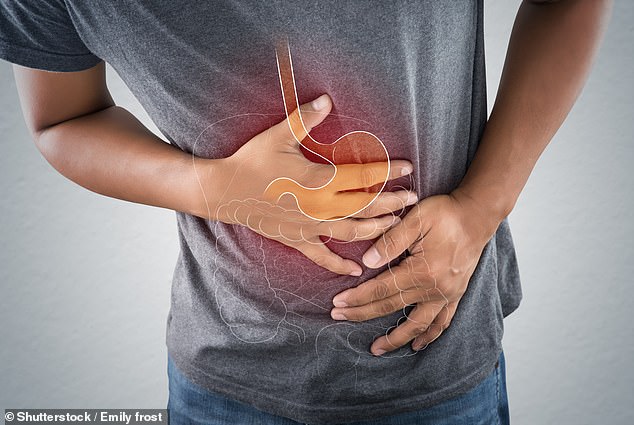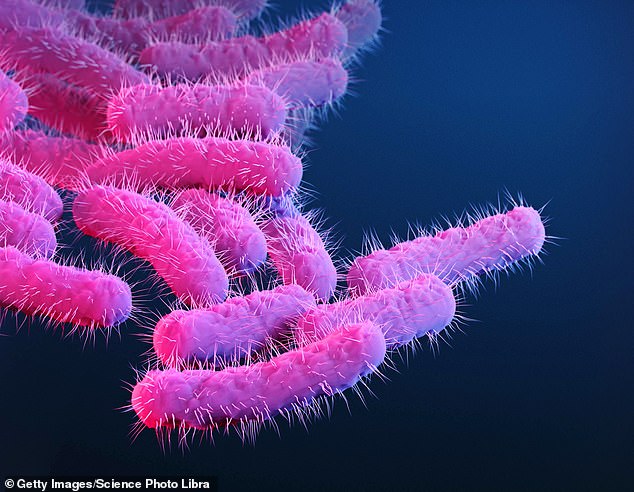EXCLUSIVE: Breakthrough as scientists discover ‘off switch’ for shigella bacterial infections – ‘we could treat diseases before they even begin’
- The infection is blocked by interfering with certain gene expression in the bacteria
- Researchers hope the discovery will pave the way for the treatment of similar bacterial diseases
- READ MORE: Man, 26, felt so sick he ‘wanted to die’ after drinking shigella
Scientists may have found a way to prevent harmful bacteria from making millions of people sick.
Microbiologists at the University of Nevada, Las Vegas, discovered that modifying a specific protein in the DNA of the shigella bacterium could prevent it from becoming infectious.
The team says this could open the door to preventing deadly bacterial infections before they strike, potentially saving millions of lives.
Monika Karney, a laboratory technician at the University of Nevada, Las Vegas, and co-author of the study, said: ‘I think our research has a broader impact.
‘What we see with this one protein in this one bacterium – there is scope to apply it to other proteins in other clinically relevant bacteria.’

Shigella causes an estimated 450,000 infections and approximately 40 deaths annually in the United States. Worldwide, the infection kills about 600,000 people every year
Infection by the shigella bacteria, which is passed through the feces, leads to about 80 million cases of shigellosis worldwide, which causes severe diarrhea, abdominal pain and fever.
About 600,000 people die every year around the world.
The VirB ‘switch’ protein produced by the shigella bacteria causes a series of actions that make it infectious.
But interfering with the expression of that protein disables the bacteria, preventing them from causing disease in the first place.
The researchers behind the discovery, which has yet to translate into an actual treatment or cure for patients, believed its applications could extend beyond just shigellosis.
This type of intervention at the DNA level could help treat very different infection-causing bacteria such as Legionella and Bartonella.

Shigella bacteria contain a ‘switch’ protein called VirB, which causes the bacterium to cause serious gastrointestinal diseases in humans
The Shigella bacterium contains genetic material that determines how it behaves and who it infects.
One protein, part of that overall genetic makeup, works by suppressing or “silencing” other proteins in the bacteria’s DNA, weaponizing Shigella.
VirB counteracts this ‘silencing’ action by binding to a DNA building block called CTP, or cytidine triphosphate, a crucial molecule for generating copies of genetic information from DNA to RNA.
The team found that blocking VirB’s ability to bind to CTP by replacing specific amino acids that make up the VirB protein “disrupts several well-documented activities of VirB, including its anti-silencing activity.”
Taylor Gerson, a fourth-year Ph.D. student at UNLV and the study’s first author said, “When molecular substitutions are made in VirB, this protein loses the ability to turn on virulence genes in Shigella, making Shigella non-infectious.”
Shigella is one of the leading causes of death from severe diarrhea worldwide, especially in developing countries.
It is easily transmitted between people when someone eats food contaminated with the bacteria or by putting something in the mouth that has come into contact with feces laced with it.
In the US, parents of small children are being told to be on high alert as daycare centers are prime breeding grounds for the spread of viruses and bacteria, while protocols such as proper hand washing and disinfection are not strictly and universally followed.
The UNLV researchers’ findings, published in the journal mBiocould pave the way for the development of very specific preventive measures to prevent the entry of many types of harmful bacteria, and not just shigella.
Dr. Helen Wing, a professor of microbiology at UNLV who led the entire effort, said, “We study these molecules to understand how they function in disease so that other labs can investigate whether drugs can be found that kill these pathogens.
‘Understanding these proteins and what they interact with is crucial.’
